A counterpunch is a boxing punch that immediately follows an attack launched by an opponent. It exploits the opening created in an opponent's guard.
A counterpunch is a boxing punch that immediately follows an attack launched by an opponent. It exploits the opening created in an opponent's guard.
Counterpunchers are tactical, fighters who find the middle of offence and defence as well as relying on opponent mistakes or their own ability to provoke an opponent's mistakes in order to gain an attacking advantage to get score cards or the chance of a knockout. They combine their offensive and defensive skills to avoid or block shots in order immediately to place well-timed punches on opponents who have lost their guard.
Boxers who fight against counter punchers must constantly feint and conceal their offensive punches to prevent anticipation for the counterpunch. Successful boxers who use this style must have good reflexes, intelligence, punch accuracy and better-than-average hand speed.
|
A cross-counter is a counter-punch begun immediately after an opponent throws a jab, exploiting the opening in the opponent's position.

Boxing is a combat sport and a martial art in which two people, usually wearing protective gloves and other protective equipment such as hand wraps and mouthguards, throw punches at each other for a predetermined amount of time in a boxing ring.

Muay Thai, sometimes referred to as Thai boxing, is a Thai martial art and full-contact combat sport that uses stand-up striking, sweeps, and various clinching techniques. This discipline is known as the "Art of eight limbs", as it is characterised by the combined use of fists, elbows, knees and shins. Muay Thai became widespread internationally in the late 20th to 21st century, when Westernised practitioners from Thailand began competing in kickboxing and mixed-rules matches as well as matches under Muay Thai rules around the world. The professional league is governed by The Professional Boxing Association of Thailand (P.A.T.), sanctioned by The Sports Authority of Thailand (S.A.T.).
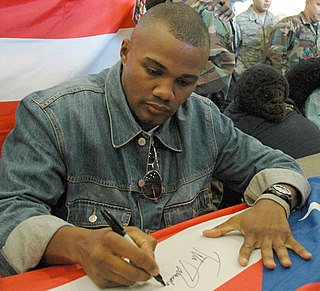
Félix Juan Trinidad García, popularly known as "Tito" Trinidad, is a Puerto Rican former professional boxer who competed from 1990 to 2008. He held multiple world championships in three weight classes and is considered to be one of the greatest Puerto Rican boxers of all time.
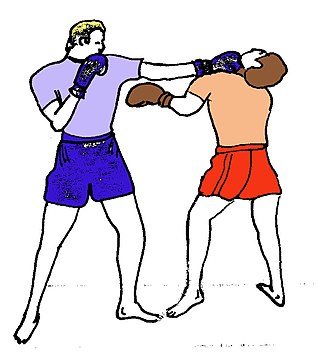
A jab is a type of punch used in martial arts. Several variations of the jab exist, but every jab shares these characteristics: while in a fighting stance, the lead fist is thrown straight ahead and the arm is fully extended from the side of the torso. This process also involves a quick turn of the torso. It is an overhand punch; at the moment of impact, the pronated fist is generally held in a horizontal orientation with the palm facing the ground.
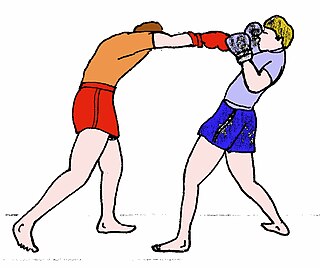
In boxing, a straight or cross are punches usually thrown with the dominant hand and are power punches like the uppercut and hook. Compubox, a computerized punch scoring system, counts the straight and cross as power punches.

A bolo punch is a punch used in martial arts. The bolo punch is not among the traditional boxing punches.

Benny Leonard was an American professional boxer who held the world lightweight championship for eight years, from 1917 to 1925. Widely considered one of the all-time greats, he was ranked 8th on The Ring magazine's list of the "80 Best Fighters of the Last 80 Years" and placed 7th in ESPN's "50 Greatest Boxers of All-Time". In 2005, the International Boxing Research Organization ranked Leonard as the #1 lightweight, and #8 best pound-for-pound fighter of all time. Statistical website BoxRec rates Leonard as the 2nd best lightweight ever, while The Ring magazine founder Nat Fleischer placed him at #2. Boxing historian Bert Sugar placed him 6th in his Top 100 Fighters catalogue.
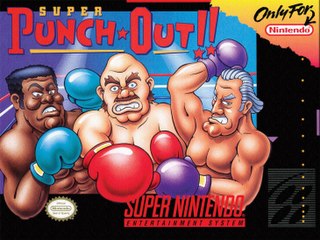
Super Punch-Out!! is a boxing video game developed and published by Nintendo for the Super Nintendo Entertainment System (SNES). It was released on September 14, 1994 in North America and again in the same region in 1996. It was released in Europe on January 26, 1995 for the same console and in Japan in 1998 for the Super Famicom through the Nintendo Power flash RAM cartridge series. The game is also included in the GameCube version of Fight Night Round 2 as an extra game due to the inclusion of Little Mac in the game. The game was released for the Wii's Virtual Console in Europe on March 20, 2009, in North America on March 30, 2009, and in Japan on July 7, 2009. The game was also released on the New Nintendo 3DS eShop on May 5, 2016. Nintendo re-released Super Punch-Out!! in the United States in September 2017 as part of the company's Super NES Classic Edition. It is the fourth game in the Punch-Out!! series, taking place after the Punch-Out!! game for the Nintendo Entertainment System (NES).
Players use different strategies while playing tennis to enhance their own strengths and exploit their opponent's weaknesses in order to gain the advantage and win more points.
The rope-a-dope is a boxing fighting technique in which one contender leans against the ropes of the boxing ring and draws non-injuring offensive punches, letting the opponent tire themself out. This gives the former the opportunity then to execute devastating offensive punches to help them win. The rope-a-dope is most famously associated with Muhammad Ali in his October 1974 Rumble in the Jungle match against world heavyweight champion George Foreman in Kinshasa, Zaire.
Peek-a-boo is a boxing style which received its common name for the defensive hand position, which are normally placed in front of the face, like in the baby's game of the same name. The technique is thought to offer extra protection to the face while making it easier to jab the opponent's face. The fighter holds their gloves close to their cheeks and pulls their arms tight against their torso. A major proponent of the style was trainer Cus D'Amato, who didn't use the term peek-a-boo and instead referred to it as a "tight defense." The style was criticized by some because it was believed that an efficient attack could not be launched from it.

Throughout the history of gloved boxing styles, techniques and strategies have changed to varying degrees. Ring conditions, promoter demands, teaching techniques, and the influence of successful boxers are some of the reasons styles and strategies have fluctuated.

In boxing and some other sports, a southpaw stance is where the boxer has the right hand and the right foot forward, leading with right jabs, and following with a left cross right hook. It is the normal stance for a left-handed boxer. The corresponding boxing designation for a right-handed boxer is the orthodox stance, which is generally a mirror-image of the southpaw stance. In American English, "southpaw" generally refers to a person who is left-handed.

Geronimo "Gerry" J. Peñalosa is a Filipino former professional boxer who competed from 1989 to 2010. He is a two-weight world champion, having held the WBC super-flyweight title from 1997 to 1998, and the WBO bantamweight title from 2007 to 2009. Originally from the city of San Carlos, Negros Occidental, Peñalosa currently resides in Manila. He was trained mainly by Freddie Roach, and went on to become a boxing trainer himself after retirement. Peñalosa's older brother, Dodie Boy Peñalosa, is also a former boxer and world champion.
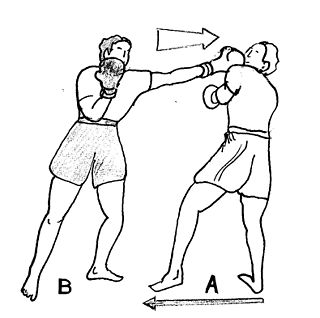
In boxing, the "one-two combo" is the name given to the combination consisting of two common punches found in boxing – a jab followed by the cross. In boxing parlance, fundamental punches are commonly assigned numbers by trainers and in this case there is the jab (#1) and the cross (#2).
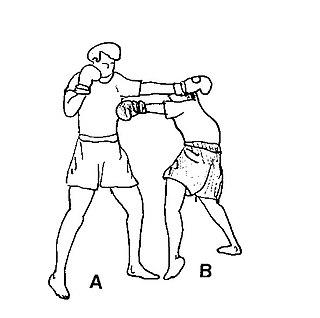
Slipping is a technique used in boxing that is similar to bobbing. It is considered one of the four basic defensive strategies, along with blocking, holding, and clinching. It is performed by moving the head to either side so that the opponent's punches "slip" by the boxer.

The uppercut is a punch used in boxing that starts low and travels upwards vertically aiming at the opponent's chin or upper abdomen. It is, along with the cross, one of the two main punches that count in the statistics as power punches.
This is a glossary of terms used in fencing.

Manny Pacquiao vs. Juan Manuel Márquez IV, billed as "Fight of the Decade", was a professional boxing match. The winner of this bout would win a commemorative belt by the WBO known as "Champion of the Decade." This was the fourth and final meeting between Pacquiao and Márquez. The bout was held on December 8, 2012, at the MGM Grand in Las Vegas, Nevada and drew 1.15 million pay-per-view buys.